The Fuchen (Horsetail Whisk) – A Taiji Study in the Yin and Yang
Tuesday, June 26, 2018
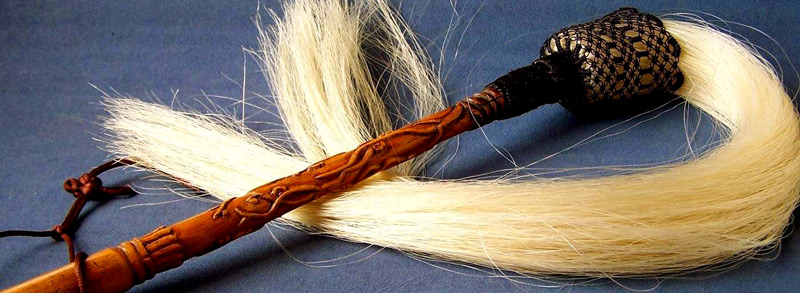
The Fúchén (拂尘 as spelt in Wudang Wushu or 佛尘 as spelt for Taiji), also known as the Horsetail Whisk, Fly Whisk or Dust Brush, is one of Chinese Martial
Arts’ most unorthodox and paradoxical weapons. It has been steeped in mystery for centuries but ironically, has gained great popularity with Western
practitioners in the 21st Century.
What is a Fúchén?
The Fúchén (Fu-chen, Fu Chen, Fochen) is essentially a whisk or brush made by binding the hair from a horse’s tail to a long wooden handle. Throughout
Chinese history the Fúchén has come in many guises from being as simple as palm fibres bound to Smilax root, through to the use of a variety of animal
hairs including Yak, being bound with hemp onto a wooden shaft. The most luxurious and expensive were of course the whisks combining unusually coloured
horse hair with handles made from things such as Cinnabar, Ivory, Mahogany, Sandalwood and Ebony.
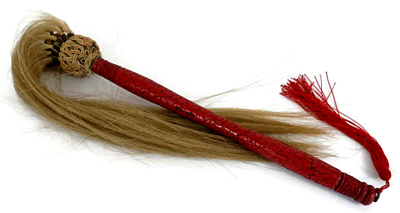 Today however, many of the whisks are made from synthetic fibres
made to look like horse hair. The prevailing view is that, while they are not natural nor as beautiful, they fall in line with the Daoist and Buddhist
philosophical principles of not causing harm to other living things. An interesting reflection when the vast majority of the whisks are bought today
for use by martial artists. Although to be fair, there wouldn’t be too many wushu practitioners now who would choose to use a fúchén in a “real fight”
situation.
Today however, many of the whisks are made from synthetic fibres
made to look like horse hair. The prevailing view is that, while they are not natural nor as beautiful, they fall in line with the Daoist and Buddhist
philosophical principles of not causing harm to other living things. An interesting reflection when the vast majority of the whisks are bought today
for use by martial artists. Although to be fair, there wouldn’t be too many wushu practitioners now who would choose to use a fúchén in a “real fight”
situation.History and Origins
This humble tool, dating back to as early as the 2nd Century BCE, originally designed to whisk away flies and mosquitos, and to gently sweep dust from
delicate surfaces, has always been considered the symbol of Daoist monastic life, particularly in Wudang Mountain, Hubei Province, China. However,
its use has actually been more far-reaching than that. We can see it turning up in Hindi, Jain, Buddhist, Polynesian and even African Maasai culture.
In all cases though, while we would expect a tool such as this to be used by peasants and workers, it has actually stayed firmly within the confines
of monasteries and monarchies as a representation of authority or its polar opposite, humility.
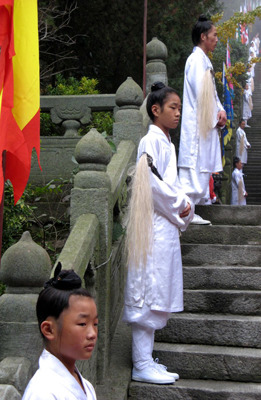 Daoism
DaoismIn Daoist practises, the Fúchén is believed to have the power to sweep away desires and evil influences both in the environment of the holder and within their own thoughts, bringing them closer to transcending the mortal realm. Many famous Taoist’s have been depicted holding a whisk including Laozi himself, the great philosopher Wang Chongyang, and even the Monkey King’s Taoist master in “Journey to the West”. In early times, a Daoist student would be sent out of the temple for 3 years to practise as a wandering monk. His teacher would give him 3 gifts to take on his journey in the hope of his devout return, one of which was the whisk. The whisk would remind the student that evil thoughts were just like mosquitos and could be swept away. If the student was successful in his journeys and returned to the monastery, he could continue his training and eventually, become an immortal.
 Buddhism
Buddhism
The Buddhists use the Fúchén as a symbol of monastic rank. It is not uncommon for Chan/Zen Buddhist Abbots to hold whisks when giving discourses on the
Dharma, symbolizing their ability to pass on spiritual teaching, along with respecting the wisdom and beauty of the teachings themselves. The whisk
is said to represent a “sweeping away of ignorance and mental afflictions” that are the root of suffering, therefore helping the practitioner to move
closer to enlightenment.
As can be seen in both Chinese philosophies, the fúchén symbolises a sweeping away of evil thoughts, cleansing the mind, and in so doing, leading one to
a state of enlightenment and immortality. It was also seen as a compassionate way of keeping flies and mosquitos at bay, as killing was seen as bad
for one’s spiritual journey. Yet from both of these belief systems and other areas within China, the whisk became a martial arts weapon capable of
killing and maiming.
Use of the Fúchén as a Martial Weapon
The use of the Fúchén as a martial weapon was popularised by the Wudang Daoist Monks. They brought the whisk to its current level of notoriety especially
given that many lay people believed it to be the only thing the Wandering Monks had available to protect themselves while out on their pilgrimage for
acceptance by their masters. In actual fact, one of the other things the Wandering Monks were given when leaving the temple was a sword, so it can
safely be assumed they would have used both weapons for self-defence if required.
 There are some magnificent Wudang double-weapon routines featuring
the use of both the sword and the whisk. The sword being another significant item in the Daoist assemblage of purifiers, having the ability to “cut
away” negative ideas, influences and evils.
There are some magnificent Wudang double-weapon routines featuring
the use of both the sword and the whisk. The sword being another significant item in the Daoist assemblage of purifiers, having the ability to “cut
away” negative ideas, influences and evils.The whisk was used as a fundamental part of the Daoist martial training but, while there are fewer writings available, it is believed the Buddhist Monks
also used the whisk as a weapon. With everything in life, it is difficult to keep something truly secret, so lay people through warring and happenstance
were also exposed the effective use of this humble object, and integrated it into their own martial training with minor variations and adaptations.
Techniques
And so we come to the weapon that the Fúchén is seen as today. A weapon that truly combines the Yin and the Yang, with a hard handle
and a soft, whip-like tail. A weapon that on its shaft has one end rounded and the other end mounted with a conical metal tip hidden under its tail.
A weapon that has its own set of techniques but also takes on a shapeshifting guise when we see techniques from the broadsword, straight sword, whip,
dart, dagger and short staff.
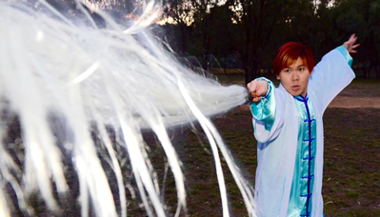 There is a veritable feast of applications that can be seen in the use of the whisk as a weapon. Again the whisk exhibits its complete
balance being as comfortable in defence as it is in attack.
There is a veritable feast of applications that can be seen in the use of the whisk as a weapon. Again the whisk exhibits its complete
balance being as comfortable in defence as it is in attack.In defence it can block, deflect, wrap and coil to protect the body, cloud, sweep, and even snatch an opponent’s weapon before counter-attacking, which
is of great use when surprise is the key to winning a fight.
In attack it can be used to strike from a wrap and coil, snap, launch a pressure point attack or divide tendons, strike to break bones, pull, snap, sweep
or stab.
However, what we shouldn’t lose sight of when considering the Fúchén as a weapon is its equal demand on us internally as externally. For it to truly shine,
the practitioner must, as always, ensure that their movements are in tune with their intentions, that the intention must be in tune with the Qi, and
that the Qi must have originated from the Shen. When this is in line, the whisk will flow like water and sigh like the wind but strike with the ferocity
of the tiger and accuracy of the snake.
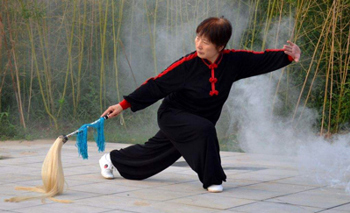 To be at one with the whisk requires you to be agile but also to possess grace and harmony of spirit. The mind needs to be quiet and free
but the body needs to be responsive. The whisk holder needs to be soft on the outside but feel the strength on the inside, to use the body efficiently
and the mind with clarity.
To be at one with the whisk requires you to be agile but also to possess grace and harmony of spirit. The mind needs to be quiet and free
but the body needs to be responsive. The whisk holder needs to be soft on the outside but feel the strength on the inside, to use the body efficiently
and the mind with clarity.In summary, the Fúchén is exotic and ordinary, humble and regal, simple and complex, celestial and mortal, mysterious and obvious, compassionate and combative,
gentle and powerful... the epitome of Yin and Yang.
For anyone who wants to truly experience the Yin and Yang in a weapon, you cannot look past the Fúchén. There is a famous Daoist saying that “the person
who holds the whisk is not an ordinary person.” Never have truer words been spoken.
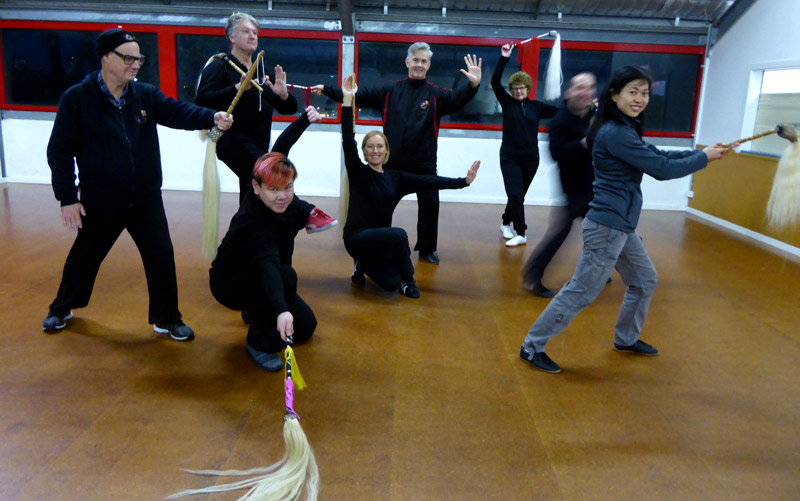
Recent Posts
- Qigong: A Guide to Understanding the Many Paths of Energy Cultivation
- The Year of the Wood Snake and Tai Chi/Qigong: A Harmonious Interplay
- An Introduction to the Six Harmonies in Taijiquan
- Tai Chi Lessons from a Broken Piano: Work with What You Have
- Tai Chi and Cage Fighting: Zhang WeiLi, China’s UFC Champion
- Studio 14 - The Launch of a Dream
- It’s The Year of the Wood Dragon – A Great Time to Dream Big
- The 21st WTQA Festival 2023 - My First Wushu Tai Chi Qigong Festival
- Spreading the Word: Presenting the Benefits of Qigong and Tai Chi to Probus Members
- Fortune, Sex, and a Good Death: The Bat in Chinese Symbology
Tags
Archive
- March 2025 (1)
- January 2025 (1)
- November 2024 (1)
- September 2024 (1)
- July 2024 (1)
- January 2024 (2)
- December 2023 (1)
- September 2023 (1)
- June 2023 (2)
- April 2023 (1)
- January 2023 (2)
- November 2022 (1)
- August 2022 (1)
- March 2022 (1)
- January 2022 (2)
- September 2021 (1)
- May 2021 (1)
- March 2021 (1)
- February 2021 (2)
- January 2021 (1)
- December 2020 (1)
- August 2020 (1)
- April 2020 (1)
- January 2020 (1)
- October 2019 (1)
- May 2019 (2)
- April 2019 (1)
- March 2019 (3)
- February 2019 (2)
- January 2019 (3)
- December 2018 (2)
- October 2018 (1)
- July 2018 (1)
- June 2018 (1)
- April 2018 (2)
- February 2018 (1)
- October 2017 (1)
- September 2017 (1)
- April 2017 (2)
- March 2017 (1)
- January 2017 (2)
- December 2016 (2)
- October 2016 (1)
- September 2016 (1)
- August 2016 (1)
- July 2016 (2)
- June 2016 (21)
